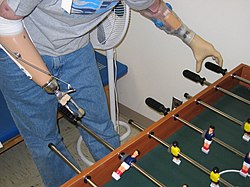Biomedical engineering
Biomedical engineering is the study of medical equipment used in an environment of care or training and how this equipment interfaces with the human body. BE applies electrical, mechanical, optical, chemical, & other engineering principles to understand, modify, or control biological systems

Biomedical engineers design, test, modify, recommend modification of, and evaluate all medical equipment used to interface or interact with the human body. In addition to these functions, clinical engineers usually supervise the biomedical equipment maintenance function within an environment of care.[1]
The medical devices include man-made hands, arms, and legs to replace lost ones and, also, Dialysis machines which clean the blood of a person with damaged kidneys.
The beginning of the modern era of bioengineering was marked by the introduction of recombinant DNA technology in the 1970’s as (DNA produced artificially in the lab.)
Biomedical Engineering Media
Hemodialysis, a process of purifying the blood of a person whose kidneys are not working normally
Example of an approximately 40,000 probe spotted oligo microarray with enlarged inset to show detail
Data obtained from crash test dummy impacts are integral to the field of biomechanics.
Micromass cultures of C3H-10T1/2 cells at varied oxygen tensions stained with Alcian blue
Schematic of silicone membrane oxygenator
Biomedical instrumentation amplifier schematic used in monitoring low voltage biological signals, an example of a biomedical engineering application of electronic engineering to electrophysiology
A T1-weighted MRI scan of a human head, an example of a biomedical engineering application of electrical engineering to diagnostic imaging. Click here to view an animated sequence of slices.
Artificial limbs: The right arm is an example of a prosthesis, and the left arm is an example of myoelectric control.
Other websites
- BioMedical Engineering OnLine
- The Biomedical Engineering Interdepartmental Program (UCLA) Archived 2012-06-07 at the Wayback Machine
| Wikimedia Commons has media related to Lua error in Module:Commons_link at line 62: attempt to index field 'wikibase' (a nil value).. |
Notes
- ↑ "The Biomedical Engineering Handbook, Third Edition". Archived from the original on 2011-08-07. Retrieved 2011-03-09.







